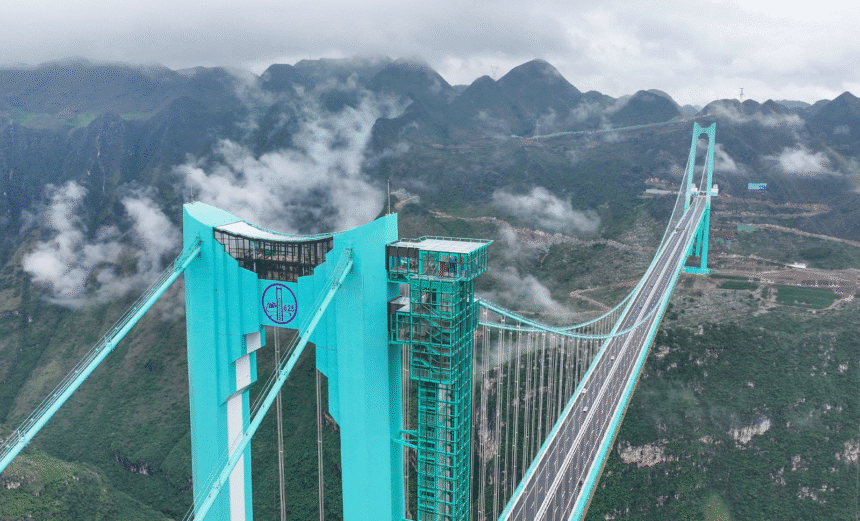China has once again redefined the limits of modern engineering with the inauguration of the world’s tallest bridge, the Beipanjiang Sky Bridge, which opened to traffic on October 1, 2025, in Guizhou Province. Towering 625 meters (2,051 feet) above the Beipan River gorge, the bridge not only sets a new world record in height but also serves as a powerful symbol of China’s determination to overcome geographical barriers and transform connectivity in its mountainous southwest.
The Beipanjiang Sky Bridge stretches 3,200 meters (10,499 feet) across rugged canyons, linking the provinces of Guizhou and Yunnan. Its central span, a staggering 1,300 meters (4,265 feet), ranks among the longest suspension spans in the world. To put its scale into perspective, the bridge is taller than the Eiffel Tower and nearly double the height of the Empire State Building. The project, which began in 2019, required six years of relentless effort, technological innovation, and the expertise of thousands of workers. With an investment of ¥12.3 billion (US$1.7 billion), the Beipanjiang Sky Bridge is one of the most ambitious infrastructure undertakings in China’s history.
The importance of the bridge extends far beyond the record books. For decades, residents and travelers in Guizhou and Yunnan have faced formidable challenges navigating the treacherous terrain. What used to be a four-hour drive across winding mountain roads has now been reduced to just 45 minutes, thanks to this engineering marvel. Speaking at the inauguration, chief engineer Chen Gang emphasized that “this bridge is not just about records; it is about transforming lives, boosting trade, and connecting communities.”
Strategically, the bridge forms a vital part of the Hangzhou–Ruili Expressway, an arterial road stretching from the eastern coastal city of Hangzhou in Zhejiang Province all the way to Ruili, a border city in Yunnan that connects with Myanmar. By completing this link, the bridge strengthens China’s internal cohesion and creates a faster trade route to Southeast Asia, supporting the broader goals of the Belt and Road Initiative. For traders, businesses, and residents, the bridge is expected to cut logistics costs, stimulate cross-border commerce, and significantly enhance accessibility.
Beyond its economic promise, the Beipanjiang Sky Bridge stands as a triumph of engineering. Built in one of the most challenging terrains on Earth, the bridge was designed to endure extreme natural conditions. It can withstand winds of up to 250 kilometers per hour thanks to aerodynamic deck shaping and ultra-strong suspension cables. In addition, because the area lies in an earthquake-prone zone, engineers incorporated state-of-the-art seismic safety systems to ensure stability during tremors. Recognizing the ecological sensitivity of the gorge, the construction process prioritized sustainability. Drones were used to install cables, minimizing blasting, and prefabricated modular components reduced the environmental footprint, setting new benchmarks for “green” infrastructure.
The socio-economic benefits are equally profound. Officials expect the bridge to become a magnet for tourism, drawing millions of visitors eager to experience its sky-high views over the Beipan River gorge. The shorter travel times will also open up opportunities for rural communities, granting them easier access to schools, hospitals, and jobs in urban centers. According to Governor Wang Xiaoling of Guizhou, “this bridge is more than concrete and steel. It is a symbol of progress, resilience, and China’s vision of future mobility.”
Globally, the Beipanjiang Sky Bridge strengthens China’s reputation as a leader in megastructure engineering. Of the ten tallest bridges in the world, eight are now in China, underscoring the country’s unmatched expertise in building infrastructure across some of the most difficult terrains on the planet. The bridge is not just a domestic achievement but a message to the world: with vision, investment, and technology, seemingly impossible challenges can be turned into gateways of opportunity.
The unveiling of the Beipanjiang Sky Bridge thus represents far more than a record-breaking construction feat. It is a bold statement about the future of transportation, a lifeline for regional development, and a critical artery in China’s expanding trade network. By bridging mountains and connecting distant communities, China has not only broken engineering records but has also reshaped the future of connectivity in Asia.














